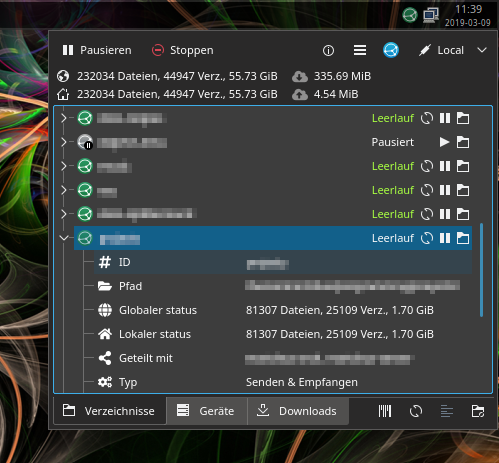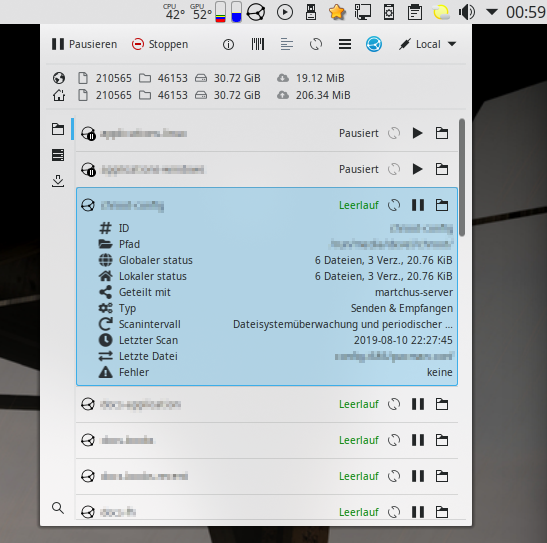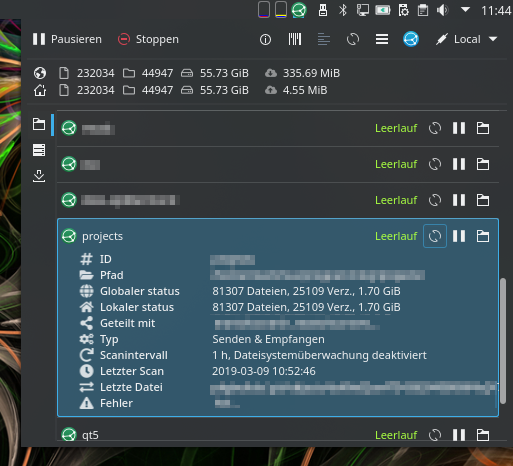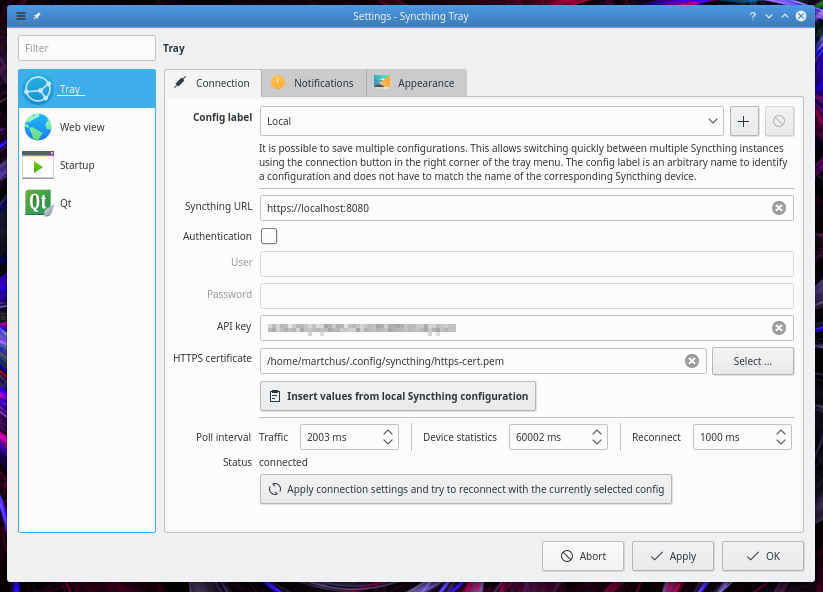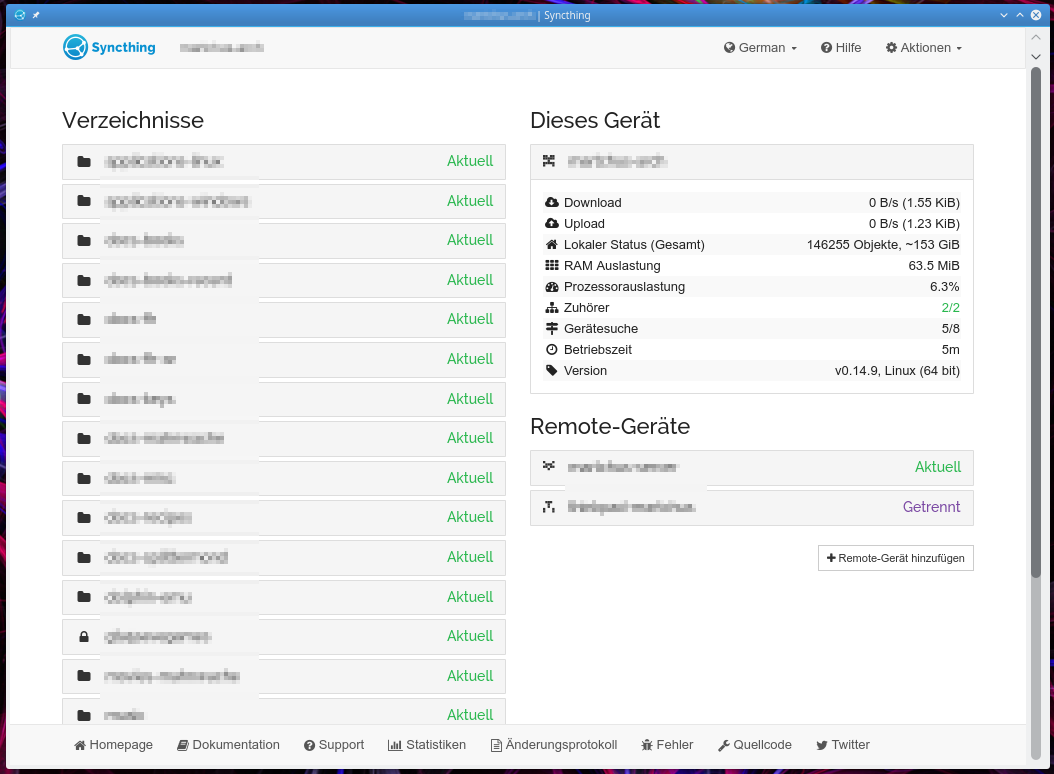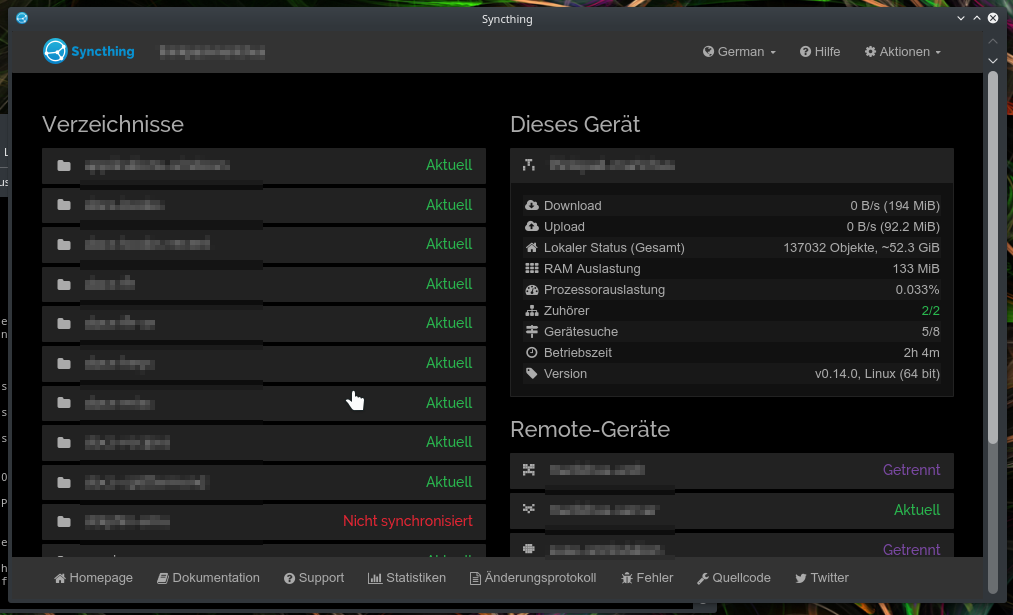|
|
||
|---|---|---|
| .github | ||
| cli | ||
| connector | ||
| fileitemactionplugin | ||
| include | ||
| libsyncthing | ||
| model | ||
| plasmoid | ||
| scripts | ||
| testhelper | ||
| tray | ||
| widgets | ||
| .gitignore | ||
| .gitmodules | ||
| CMakeLists.txt | ||
| LICENSE | ||
| LICENSE.LESSER | ||
| LICENSE.MPL-2.0 | ||
| LICENSES-windows-distribution.md | ||
| README.md | ||
README.md
Syncthing Tray
- Qt-based tray application
- Dolphin/Plasma integration
- command-line interface
- Qt-ish C++ interface to control Syncthing
Checkout the official forum thread for discussions and announcement of new features.
Issues can be created on GitHub but please read the "Known bugs and workarounds" section in this document before.
I provide binaries/repositories for some platforms. There are also binaries/repositories provided by other distributors. For a list with links, checkout the Download section of this document. The release section on GitHub only contains a fraction of the available options.
Supported platforms
- Designed to work under any desktop environment supported by Qt with tray icon support (can be shown as regular window if tray icon support is not available)
- No desktop environment specific libraries required (only for optional features/integrations)
- Known to work under
- Plasma
- Openbox/lxqt/LXDE
- Openbox/qt5ct/Tint2
- Awesome/qt5ct
- Cinnamon (native look and feel using adwaita-qt)
- Deepin Desktop Environment
- Xfce
- Sway/Swaybar/Waybar
- Windows 10
- macOS 10.14 Mojave
For Plasma, there's (in addition to the Qt Widgets based version) also a "native" Plasmoid. Note that the latest version of Syncthing Tray generally also requires the latest version of Plasma as no testing on earlier versions is done. Use the Qt Widgets based version on older Plasma versions.
The section "Known bugs and workarounds" below contains information and workarounds for certain caveats.
Features
- Provides quick access to most frequently used features but does not intend to replace the official web UI
- Check state of directories and devices
- Check current traffic statistics
- Display further details about directories and devices, like last file, last scan, items out of sync, ...
- Display ongoing downloads
- Display Syncthing log
- Trigger re-scan of a specific directory or all directories at once
- Open a directory with the default file browser
- Pause/resume a specific device or all devices at once
- Pause/resume a specific directory
- View recent history of changes (done locally and remotely)
- Shows notifications
- The notification to show is configurable
- Uses Qt's notification support or a D-Bus notification daemon directly
- Reads connection parameters from Syncthing config file for quick setup (when just connecting to local instance)
- Allows monitoring the status of the Syncthing systemd unit and to start and stop it (see section Configuring systemd integration)
- Provides an option to conveniently add the tray to the applications launched when the desktop environment starts
- Can launch Syncthing automatically when started and display stdout/stderr (useful under Windows)
- Provides quick access to the official web UI
- Utilizes either Qt WebEngine or Qt WebKit
- Can be built without web view support as well (then the web UI is opened in the regular browser)
- Allows switching quickly between multiple Syncthing instances
- Also features a simple command line utility
syncthingctl- Check status
- Trigger rescan/pause/resume/restart
- Wait for idle
- View and modify raw configuration
- Supports Bash completion, even for directory and device names
- Also bundles a KIO plugin which shows the status of a Syncthing directory and allows to trigger Syncthing actions
in Dolphin file manager
- Rescan selected items
- Rescan entire Syncthing directory
- Pause/resume Syncthing directory
- See also screenshots section
- Also has an implementation as Plasmoid for Plasma 5 desktop
- Allows building Syncthing as a library to run it in the same process as the tray/GUI (optional build configuration which is not enabled by default)
- English and German localization
Does this launch or bundle Syncthing itself? What about my existing Syncthing installation?
Syncthing Tray does not launch Syncthing itself by default. There should be no interference with your existing Syncthing installation. You might consider different configurations:
- If you're happy how Syncthing is started on your system so far just tell Syncthing Tray to connect to your currently running Syncthing instance in the settings. If you're currently starting Syncthing via systemd you might consider enabling the systemd integration in the settings (see section Configuring systemd integration).
- If you would like Syncthing Tray to take care of starting Syncthing for you, you can use the Syncthing launcher
available in the settings.
- The Windows builds provided in the release section on GitHub come with a built-in version of Syncthing which you can consider to use. Keep in mind that automatic updates of Syncthing are not possible this way.
- In any case you can simply point the launcher to the binary of Syncthing (which you have to download/install separately).
- Checkout the Configuring the built-in launcher section for further details.
- It is also possible to let Syncthing Tray connect to a Syncthing instance running on a different machine.
Screenshots
The screenshots are not up-to-date.
Qt Widgets based GUI under Openbox/Tint2 with dark Breeze theme
Under Plasma 5
Light theme
Dark theme
Customized icons
Settings dialog
Web view
Syncthing actions for Dolphin
Configuring Plasmoid and Dolphin integration
The Dolphin integration can be enabled/disabled in Dolphin's context menu settings.
The Plasmoid can be added to a panel or the desktop like any other Plasmoid. It can also be shown as part of the system tray Plasmoid. That can be configured in the settings of the system tray Plasmoid. This way it is also possible to show the icon only in certain states by choosing to show it only when important and selecting the states in the Plasmoid's settings. Note that configuring the size has no effect when the Plasmoid is displayed as part of the system tray Plasmoid.
Configuring systemd integration
The next section explains what it is good for and how to use it. If it doesn't work on your system please read the subsequent sections as well before filing an issue.
Using the systemd integration
With the system configured correctly and systemd support enabled at build-time the following features are available:
- Starting and stopping the systemd unit of Syncthing
- Consider the unit status when connecting to the local instance to prevent connection attempts when Syncthing isn't running anyways
- Detect when the system has just been resumed from standby to avoid the "Disconnect" notification in that case
However, these features are optional. To use them they must be enabled in the settings dialog first.
It is recommended to enable "Consider unit status …". Note that Syncthing might still not be immediately ready to serve API requests when the systemd unit turns active. Hence it is still required to configure a re-connect interval. The re-connect interval will only be in effect while the systemd unit is active. So despite the re-connect interval there will be no connection attempts while the systemd unit is inactive. That's all the systemd integration can optimize in that regard.
Be aware that Syncthing Tray assumes by default that the systemd unit is a
user unit. If you are using
a regular system-wide unit (including those started with …@username) you need to enable the
"System unit" checkbox in the settings. Note that starting and stopping the system-wide Syncthing
unit requires authorization (systemd can ask through PolicyKit).
Required system configuration
The communication between Syncthing Tray and systemd is implemented using systemd's D-Bus service.
That means systemd's D-Bus service (which is called org.freedesktop.systemd1) must be running on
your D-Bus. For user units the session D-Bus is
relevant and for regular units (including those started with …@username) the system D-Bus is relevant.
It seems that systemd's D-Bus service is only available when D-Bus itself is started via systemd. That
is by default the case under Arch Linux and openSUSE and likely most other modern distributions where
it is usually started via "socket activation" (e.g. /usr/lib/systemd/user/dbus.socket for the session
D-Bus).
All of this counts for the session D-Bus and for the system D-Bus although the startup of the session
D-Bus can be screwed up particularly easy. One easy way to screw it up is to start a second instance of
the session D-Bus manually e.g. via dbus-run-session. When starting the session D-Bus this way the
systemd integration will not work and you will likely end up with two session D-Bus processes. It is
also worth noticing that you do not need to set the DBUS_SESSION_BUS_ADDRESS variable manually
because the systemd file dbus.socket should take care of this.
Note that the Plasma Wayland session screwed things up in the way I've described. This has been fixed with Only spawn dbus-run-session if there isn't a session already but this change might not be available on older distributions.
Build-time configuration
The systemd integration can be explicitly enabled/disabled add compile time by adding
-DSYSTEMD_SUPPORT=ON/OFF to the CMake arguments. If the systemd integration does not work be sure your
version of Syncthing Tray has been compiled with systemd support.
Note for distributors: There will be no hard dependency to systemd in any case. Distributions supporting alternative init systems do not need to provide differently configured versions of Syncthing Tray. Disabling the systemd integration is mainly intended for systems which do not use systemd at all (e.g. Windows and MacOS).
Configuring the built-in launcher
The built-in launcher can be accessed and configured within the settings dialog. The GUI should be self-explaining.
It is recommended to enable "Consider process status …". Note that Syncthing might not be immediately ready to serve API requests when started. Hence it is still required to configure a re-connect interval. The re-connect interval will only be in effect while the Syncthing process is running. So despite the re-connect interval there will be no connection attempts while the Syncthing process is not running.
Configuring hotkeys
Use the same approach as for launching an arbitrary application via a hotkey. Make it invoke
syncthingtray --triggerto show the Qt Widgets based tray menu.syncthingtray --webuito show the web UI.syncthingctl [...]to trigger a particular action. Seesyncthingctl -hfor details.
The Plasmoid can be shown via a hot-key as well by configuring one in the Plasmoid settings.
Download
Source
See the release section on GitHub.
Packages and binaries
- Arch Linux
- for PKGBUILDs checkout my GitHub repository or the AUR
- there is also a binary repository
- Tumbleweed, Leap, Fedora
- RPM *.spec files and binaries are available via openSUSE Build Service
- remarks
- Be sure to add the repository that matches the version of your OS and to keep it in sync when upgrading.
- The linked download pages might be incomplete, use the repositories URL for a full list.
- latest releases: download page, repositories URL, project page
- Git master: download page, repositories URL, project page
- remarks
- available split packages
syncthingtray: Qt-widgets based GUIsyncthingplasmoid: applet/plasmoid for Plasma desktopsyncthingfileitemaction: Dolphin/KIO integrationsyncthingctl: command-line interface
- RPM *.spec files and binaries are available via openSUSE Build Service
- Other GNU/Linux systems
- for generic, self-contained binaries checkout the release section on GitHub
- Requires glibc>=2.26, OpenGL and libX11
- openSUSE Leap 15, Fedora 27, Debian 10 and Ubuntu 18.04 are recent enough (be sure
the package
libopengl0is installed on Debian/Ubuntu)
- openSUSE Leap 15, Fedora 27, Debian 10 and Ubuntu 18.04 are recent enough (be sure
the package
- Supports X11 and Wayland (set the environment variable
QT_QPA_PLATFORM=xcbto disable native Wayland support if it does not work on your system)
- Requires glibc>=2.26, OpenGL and libX11
- for generic, self-contained binaries checkout the release section on GitHub
- Windows
- for binaries checkout the release section on GitHub
- the Qt 6 based version is stable and preferable but only supports Windows 10 and newer
- the Qt 5 based version should still work on older versions down to Windows 7 although this is not regularly checked
- for mingw-w64 PKGBUILDs checkout my GitHub repository
- for binaries checkout the release section on GitHub
- NixOS
- the package syncthingtray is available from the official repositories
- FreeBSD
- the package syncthingtray is available from FreeBSD Ports
- Mac OS X/macOS
- the package syncthingtray is available from MacPorts
- Exherbo
- packages for my other project "Tag Editor" and dependencies could serve as a base and are provided by the platypus repository
- Gentoo
- packages for my other project "Tag Editor" and dependencies could serve as a base and are provided by perfect7gentleman's repository
Build instructions
The application depends on c++utilities, qtutilities and qtforkawesome and is built the same way as these libraries. For basic instructions checkout the README file of c++utilities.
To avoid building c++utilities/qtutilities/qtforkawesome separately, follow the instructions under "Building this straight". There's also documentation about various build variables which can be passed to CMake to influence the build.
Further dependencies
The following Qt modules are required (version 5.6 or newer): core, network, dbus, gui, widgets,
svg, webenginewidgets/webkitwidgets
It is recommended to use at least Qt 5.14 to avoid limitations in previous versions (see Known bugs section).
The built-in web view and therefore the modules webenginewidgets/webkitwidgets are optional (see section Select Qt module for WebView).
To build the plugin for Dolphin integration KIO is also required. Additionally, the Dolphin plugin requires
Qt 5.8 or newer. To skip building the plugin, add -DNO_FILE_ITEM_ACTION_PLUGIN:BOOL=ON to the CMake arguments.
To build the Plasmoid for the Plasma desktop, the Qt module QML and the KDE Frameworks module Plasma are
required as well. Additionally, the Plasmoid requires Qt 5.15 or newer. To skip building the Plasmoid, add
-DNO_PLASMOID:BOOL=ON to the CMake arguments.
To specify the major Qt version to use, set QT_PACKAGE_PREFIX (e.g. add -DQT_PACKAGE_PREFIX:STRING=Qt6
to the CMake arguments). There's also KF_PACKAGE_PREFIX for KDE dependencies. Note that KDE integrations
always require the same major Qt version as your KDE installation uses.
The following Boost libraries are required: Boost.Asio, Boost.Process, Boost.Filesystem
The launcher uses these libraries by default to handle sub processes correctly (and avoid leftover processes).
Add -DUSE_BOOST_PROCESS:BOOL:OFF to the CMake arguments to get rid of the dependency to Boost libraries.
This disables handling sub processes and QProcess (from Qt Core) is used instead.
It is also possible to build only the CLI (syncthingctl) by adding -DNO_MODEL:BOOL=ON and
-DNO_FILE_ITEM_ACTION_PLUGIN:BOOL=ON to the CMake arguments. Then only the Qt modules core,
network and dbus are required.
To get rid of systemd support, add -DENABLE_SYSTEMD_SUPPORT_BY_DEFAULT to the CMake arguments.
In this case the Qt module dbus is not required anymore. Note that there is no hard dependency
to systemd in any case.
Building the testsuite requires CppUnit and Qt 5.8 or higher.
Building this straight
- Install (preferably the latest version of) the CGG toolchain or Clang, the required Qt modules, iconv, CMake and Ninja.
- Get the sources. For the latest version from Git clone the following repositories:
Note thatcd "$SOURCES" git clone -c core.symlinks=true https://github.com/Martchus/cpp-utilities.git c++utilities git clone -c core.symlinks=true https://github.com/Martchus/qtutilities.git git clone -c core.symlinks=true https://github.com/Martchus/qtforkawesome.git git clone -c core.symlinks=true https://github.com/ForkAwesome/Fork-Awesome.git forkawesome git clone -c core.symlinks=true https://github.com/Martchus/syncthingtray.git git clone -c core.symlinks=true https://github.com/Martchus/subdirs.git-c core.symlinks=trueis only required under Windows to handle symlinks correctly. This requires a recent Git version and a filesystem which supports symlinks (NTFS works). If you run into "not found" errors on symlink creation usegit reset --hardwithin the repository to fix this. - Configure the build
cd "$BUILD_DIR" cmake \ -DCMAKE_BUILD_TYPE=Release \ -DCMAKE_INSTALL_PREFIX="/install/prefix" \ -DFORK_AWESOME_FONT_FILE="$SOURCES/forkawesome/fonts/forkawesome-webfont.woff2" \ -DFORK_AWESOME_ICON_DEFINITIONS="$SOURCES/forkawesome/src/icons/icons.yml" \ "$SOURCES/subdirs/syncthingtray"- Replace
/install/prefixwith the directory where you want to install. - Checkout the Providing the font file section of qtforkawesome's README for details regarding the ForkAwesome-related parameters.
- Replace
- Build and install everything in one step:
cd "$BUILD_DIR" ninja install- If the install directory is not writable, do not conduct the build as root. Instead, set
DESTDIRto a writable location (e.g.DESTDIR="temporary/install/dir" ninja install) and move the files from there to the desired location afterwards.
- If the install directory is not writable, do not conduct the build as root. Instead, set
Select Qt module for web view and JavaScript
- Add
-DWEBVIEW_PROVIDER:STRING=webkit/webengine/noneto the CMake arguments to use either Qt WebKit (works with 'revived' version as well), Qt WebEngine or no web view at all. If no web view is used, the Syncthing web UI is opened in the default web browser. Otherwise the user can choose between the built-in web view and the web browser. - Add
-DJS_PROVIDER:STRING=script/qml/noneto the CMake arguments to use either Qt Script, Qt QML or no JavaScript engine at all. If no JavaScript engine is used, the CLI does not support scripting configuration changes.
Limitations of Qt WebEngine compared to Qt WebKit
- When using a version of Qt older than 5.14 there is no way to allow only a particular self-signed certificate in Qt WebEngine. That means any self-signed certificate is accepted! See: https://bugreports.qt.io/browse/QTBUG-51176
- Qt WebEngine can not be built with GCC/mingw-w64 for Windows.
- Security issues are not a concern because no other website than the Syncthing web UI is shown. Any external links will be opened in the regular web browser anyways.
Troubleshooting KDE integration
If the Dolphin integration or the Plasmoid does not work, check whether the files for those components have been installed in the right directories.
For instance, under Tumbleweed it looks like this for the Plasmoid:
/usr/lib64/qt5/plugins/plasma/applets/libsyncthingplasmoid.so
/usr/share/kservices5/plasma-applet-martchus.syncthingplasmoid.desktop
/usr/share/plasma/plasmoids/martchus.syncthingplasmoid/contents/ui/*.qml
/usr/share/plasma/plasmoids/martchus.syncthingplasmoid/metadata.desktop
/usr/share/plasma/plasmoids/martchus.syncthingplasmoid/metadata.json
The files for the Dolphin integration look like this under Tumbleweed:
/usr/lib64/qt5/plugins/libsyncthingfileitemaction.so
/usr/share/kservices5/syncthingfileitemaction.desktop
The directory where the *.so file needs to be installed to, seems to differ from distribution to
distribution. The right directory for your distribution can be queried from qmake using
qmake-qt5 -query QT_INSTALL_PLUGINS. In doubt, just look where other Qt plugins are stored.
Actually, the build system should be able to do that query automatically. It is also possible to
specify the directory manually, e.g. for Tumbleweed one would add
-DQT_PLUGIN_DIR=/usr/lib64/qt5/plugins to the CMake arguments.
Also be sure that the version of the plasma framework the plasmoid was built against is not newer
than the version actually installed on the system. That can for instance easily happen when using
tumbleweed-cli for sticking to a previous snapshot but having the latest version of the plasmoid
from my home repository installed.
If the Plasmoid still won't load, checkout the log of plasmashell/plasmoidviewer/plasmawindowed.
Also consider using strace to find out at which paths the shell is looking for *.desktop and
*.so files.
For a development setup of the KDE integration, continue reading the subsequent section.
Contributing, developing, debugging
Translations
Currently translations for English and German are available. Qt's built-in localization/translation framework is used under the hood.
Note that syncthingctl has not been internationalized yet so it supports only English.
Add a new locale
Translations for further locales can be added quite easily:
- Append a new translation file for the desired locale to the
TS_FILESlist inconnector/CMakeLists.txt,model/CMakeLists.txt,widgets/CMakeLists.txt,fileitemactionplugin/CMakeLists.txt,plasmoid/CMakeLists.txtandtray/CMakeLists.txt. - Configure a new build, e.g. follow steps under Building this straight.
- Conduct a full build or generate only translation files via the
translationstarget. - New translation files should have been created by the build system under
connector/translations,model/translations,widgets/translations,fileitemactionplugin/translations,plasmoid/translationsandtray/translationsand thetranslationsfolder ofqtutilities. - Open the files with Qt Linguist to add translations. Qt Linguist is part of the Qt Tools repository and its usage is well documented.
Extend/update existing translations
- For English, update the corresponding string literals within the source code.
- If necassary, sync the translation files with the source code like in step
2./3.of "Add a new locale". Check that no translations have been lost (except ones which are no longer required of course). - Change the strings within the translation files found within the
translationsdirectories like in step4./5.of "Add a new locale".
Remarks
- Syncthing Tray displays also text from qtutilities. Hence it makes sense adding translations there as well (following the same procedure).
- The CLI
syncthingctlcurrently does not support translations.
Using backend libraries
The contained backend libraries (which provide connecting to Syncthing, data models and more) are written for internal use within the components contained by this repository.
Hence those libraries do not provide a stable ABI/API. If you like to use them to develop Syncthing integration or tooling with Qt and C++, it makes most sense to contribute it as an additional component directly to this repository. Then I will be able to take it into account when changing the API.
KDE integration
Since the Dolphin integration and the Plasmoid are plugins, testing and debugging requires a few extra steps. See Testing and debugging Dolphin/KIO plugin with Qt Creator and Testing and debugging Plasma 5 plasmoid with Qt Creator.
Logging
It is possible to turn on logging of the underlying library by setting environment variables:
LIB_SYNCTHING_CONNECTOR_LOG_ALL: log everything mentioned in points belowLIB_SYNCTHING_CONNECTOR_LOG_API_CALLS: log calls to Syncthing's REST-APILIB_SYNCTHING_CONNECTOR_LOG_API_REPLIES: log replies from Syncthing's REST-API (except events)LIB_SYNCTHING_CONNECTOR_LOG_EVENTS: log events emitted by Syncthing's events REST-API endpointLIB_SYNCTHING_CONNECTOR_LOG_DIRS_OR_DEVS_RESETTED: log when directories/devices are internally reset
Known bugs and workarounds
The following bugs are caused by dependencies or limitations of certain platforms. For bugs of Syncthing Tray itself, checkout the issues on GitHub.
Workaround positioning issues under Wayland
The Qt Widgets based version basically works under Wayland but there are positioning issues and the settings regarding positioning have no effect (see "List of bugs" section below). One can workaround this limitation by telling the window manager how to place the window, e.g. under Sway one could add a configuration like this:
for_window [title="^Syncthing Tray( \(.*\))?$"] floating enable, border none, resize set 450 400, move position 916 0
Workaround missing support for Windows 10 dark mode
The dark mode introduced in Windows 10 does not affect traditional desktop applications like Syncthing Tray. Unfortunately, Windows normal theming capabilities have been removed. So far Qt does not offer much to improve the situation (see "List of bugs" below).
However, it is possible to use Syncthing Tray's custom appearance settings to achieve a dark theming:
- To enable dark Window borders, set the environment variable
QT_QPA_PLATFORMtowindows:darkmode=1or create a file calledqt.confnext tosyncthingtray.exewith the contents:[Platforms] WindowsArguments = darkmode=1 - To enable dark colors for Syncthing Tray's UI elements, configure a dark color palette in Syncthing Tray's settings under "Qt/Appearance". You can download and load the file as a base https://raw.githubusercontent.com/Martchus/syncthingtray/master/tray/resources/dark-palette.ini and tweak the colors to your liking.
- To make the rest of the colors used by Syncthing Tray fit with the dark color palette, enable "Bright custom text colors" in Syncthing Tray's settings under "Tray/Appearance".
- To make general icons fit with the dark color palette, configure an appropriate icon them, e.g. select "Breeze Dark" as icon theme in Syncthing Tray's settings under "Qt/Appearance".
- To make Syncthing icons fit with the dark color palette, configure their colors in Syncthing Tray's settings under "Tray/UI icons" and "Tray/System icons". The "Use preset" button allows to select pre-defined colors suitable for a dark color palette.
- Select the widgets style "Fusion" under "Qt/Appearance". This is required because the native styling provided by Windows for traditional desktop applications does not look very nice when using a dark color palette.
After changing these settings, restart Syncthing Tray. It is not sufficient to close the last Windows; the process needs to be restarted.
It is also possible to enable Windows' "High contrast" setting which seems to bring back the traditional theming/coloring but unfortunately doesn't look very nice overall. Check https://github.com/tomasz1986/classic2000 to see how Windows looks like with high contrast applied, or if you're in need for themes that look at least nicer than what's shipped with Windows.
Enable experimental support for Windows' per-monitor DPI awareness (V2)
PMv2
is not working out of the box but experimental support can be enabled in the
Qt 6 build by setting the environment variable QT_QPA_PLATFORM to
windows:dpiawareness=3 or set it via qt.conf as described in the previous
section.
List of bugs
- Wayland limitations
- The tray menu can not be positioned correctly under Wayland because the protocol does not allow setting window positions from the client-side (at least I don't know a way to do it). This issue can not be fixed unless Wayland provides an API to set the window position to specific coordinates or a system tray icon. See discussion on freedesktop.org. Note that the Plasmoid is not affected by this limitation.
- While the tray menu is shown its entry is shown in the taskbar. Not sure whether there is a way to avoid this.
- Qt bugs
- Qt < 5.14
- Any self-signed certificate is accepted when using Qt WebEngine due to https://bugreports.qt.io/browse/QTBUG-51176.
- Qt < 5.9:
- Pausing/resuming folders and devices doesn't work when using scan-intervals with a lot of zeros because of Syncthing bug https://github.com/syncthing/syncthing/issues/4001. This has already been fixed on the Qt-side with https://codereview.qt-project.org/#/c/187069/. However, the fix is only available in Qt 5.9 and above.
- any Qt version:
- The tray disconnects from the local instance when the network connection goes down. The network connection must be restored or the tray restarted to be able to connect to local Syncthing again. This is caused by Qt bug https://bugreports.qt.io/browse/QTBUG-60949.
- The dark mode introduced in Windows 10 is not supported, see https://bugreports.qt.io/browse/QTBUG-72028.
- Qt < 5.14
- KDE limitations
- High-DPI scaling of Plasmoid is broken under X11 (https://bugs.kde.org/show_bug.cgi?id=356446).
- The Plasmoid contents are possibly clipped when shown within the system notifications plasmoid.
- Systemd integration
- This feature relies especially on the system being correctly configured. Checkout the Required system configuration section for details.
Copyright notice and license
Copyright © 2016-2022 Marius Kittler
All code is licensed under GPL-2-or-later. This does not apply to code contained in Git repositories included as Git submodule (which contain their own README and licensing information).
Attribution for 3rd party content
- Some icons are taken from Fork Awesome (see their license). These are provided via qtforkawesome.
- The Syncthing icons are taken from the Syncthing project.
- All other icons found in this repository are taken from the KDE/Breeze project.
None of these icons have been (intentionally) modified so no copyright for modifications is asserted.


